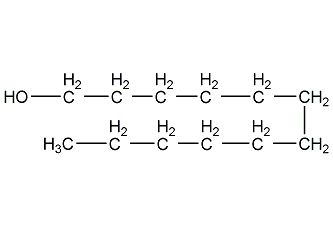
Structural formula
| Business number | 0360 |
|---|---|
| Molecular formula | C12H26O |
| Molecular weight | 186.33 |
| label |
Lauryl alcohol; dodecyl alcohol, Lauryl alcohol, n-Dodecyl alcohol, surfactant raw materials, essence, alcohol solvent |
Numbering system
CAS number:112-53-8
MDL number:MFCD00004753
EINECS number:203-982-0
RTECS number:JR5775000
BRN number:1738860
PubChem number:24867633
Physical property data
1. Properties: light yellow oily liquid or solid, crystallizes into flakes in acetic acid. It has a slight aroma of moonflower and violet, and has a weak but long-lasting oil smell.
2. Relative density (g/mL, 24/4℃): 0.8309
3. Melting point (ºC): 24
4. Boiling point (ºC ): 259
5. Boiling point (ºC, 1999.83KPa): 150
6. Refractive index (20ºC): 1.4282
7. Flash point (ºC , closed): >100
8. Viscosity (mPa·s, 20ºC): 1.15
9. Vapor pressure (kPa, 91ºC): 0.13
10. Freezing point (ºC): 23.95
11. Solubility: Insoluble in water, soluble in ethanol and ether.
12. Relative density (20℃, 4℃): 0.8343
13. Relative density (25℃, 4℃): 0.8308
14. Normal temperature Refractive index (n20): 1.4428
15. Refractive index at room temperature (n25): 1.4413
16. Critical Temperature (ºC): 446.25
17. Critical pressure (MPa): 1.994
18. Eccentricity factor: 0.693
19. Solubility parameter (J· cm-3)0.5: 19.485
20. van der Waals area (cm2·mol– 1): 1.843×1010
21. van der Waals volume (cm3·mol-1): 134.240
22. Gas phase standard combustion heat (enthalpy) (kJ·mol-1): -8001.36
23. Gas phase standard claim Heat (enthalpy) (kJ·mol-1): -436.52
24. Liquid phase standard combustion heat (enthalpy) (kJ·mol-1): -7909.39
25. Liquid phase standard claims heat (enthalpy) (kJ·mol-1): -528.48
26. Liquid phase Standard hot melt (J·mol-1·K-1): 493.2
Toxicological data
1. Acute toxicity: Rat oral LD50: >12800mg/kg; intraperitoneal injection LD50: 800~1600mg/kg; guinea pig transdermal LD50: >10ug/kg
2. Stimulation data: Skin – Human 75 mg/3 days Severe.
3. Skin protection��No irritating effect. The olfactory threshold concentration is 0.054mg/m3.
Ecological data
This substance may be harmful to the environment, and special attention should be paid to water bodies.
Molecular structure data
1. Molar refractive index: 59.17
2. Molar volume (cm3/mol): 224.1
3. Isotonic specific volume (90.2K ): 526.3
4. Surface tension (dyne/cm): 30.4
5. Polarizability (10-24cm3): 23.46
Compute chemical data
1. Reference value for hydrophobic parameter calculation (XlogP): None
2. Number of hydrogen bond donors: 1
3. Number of hydrogen bond acceptors: 1
4. Number of rotatable chemical bonds: 10
5. Number of tautomers: none
6. Topological molecule polar surface area 20.2
7. Number of heavy atoms: 13
8. Surface charge: 0
9. Complexity: 81.2
10. Number of isotope atoms: 0
11. Determine the number of atomic stereocenters: 0
12. Uncertain number of atomic stereocenters: 0
13. Determine the number of chemical bond stereocenters: 0
14. Number of uncertain chemical bond stereocenters: 0
15. Number of covalent bond units: 1
Properties and stability
1. Avoid contact with oxidants, acids, acidic chlorides, and acid anhydrides. It has the chemical reactivity of higher primary alcohols.
2. Almost non-toxic. Oral LD50 of rats: 6400~12800mg/kg, mice 12800~25600mg/kg. Mice were intraperitoneally injected with LC5080800~1600mg/kg.
Storage method
1. Packed in galvanized iron drums, net weight 150kg per drum. Store in a cool and ventilated place, away from fire sources and away from direct sunlight.
2. Generally, iron drums are used, and large quantities can be transported by tank trucks. Refined products can be packaged in glass bottles or iron cans. The storage tank should be grounded and use a flame arrester to prevent fire. It is advisable to protect yourself from the sun and stay away from fire and heat sources. Store and transport according to general chemical regulations.
Synthesis method
1, high voltage Hydrogenated coconut oil is continuously hydrogenated in a copper-chromium catalyst to obtain C8-C18 mixed alcohol. The glycerin in the oil is hydrogenolyzed into isopropyl alcohol and water. After mixing the fatty alcohol and evaporating the water and isopropyl alcohol frequently under pressure, distill under reduced pressure to cut C8-C10 alcohol and C12-C14 alcohols and C16-C18alcohols.

2, esterified hydrogenated coconut oil In the presence of sulfuric acid, a transesterification reaction occurs with methanol to generate methyl laurate and glycerol. After catalytic hydrogenation and distillation, lauryl alcohol is obtained.
Purpose
1. Used in the manufacture of high-efficiency detergents, surfactants, foaming agents, hair care agents, milk selection agents, textile oil agents, bactericides, cosmetics, plasticizers, plant growth regulators, lubricating oil additives and Some other special chemicals are widely used in light industry, chemical industry, metallurgy, medicine and other industrial products. Dodecanol has the aroma of moonflower and violet, and can be used in rose, violet and lily-narcissus flavors. Chemically stable, it is safe to use in soap fragrances.
2. Used in various cosmetics such as cream, cold cream, lotion, conditioner, etc., and also used in rose, violet and lily fragrance formulas.

 微信扫一扫打赏
微信扫一扫打赏

